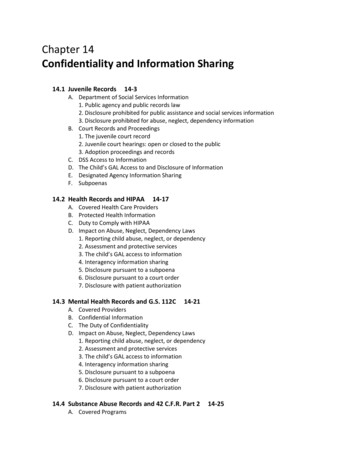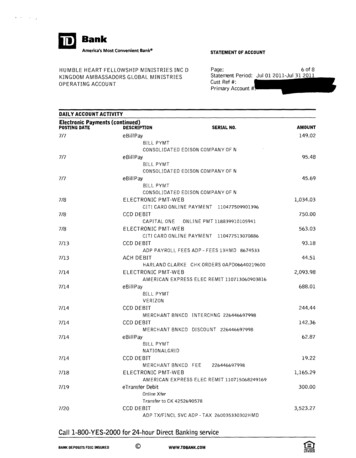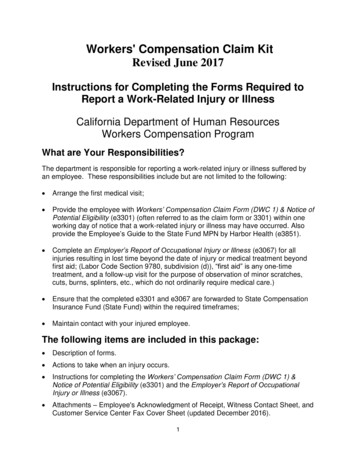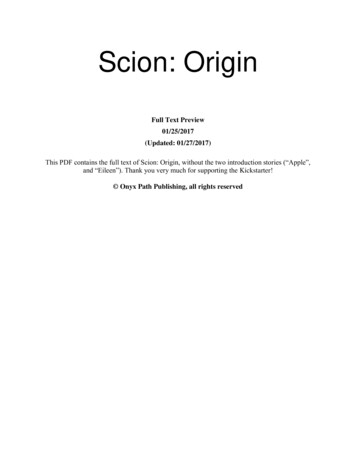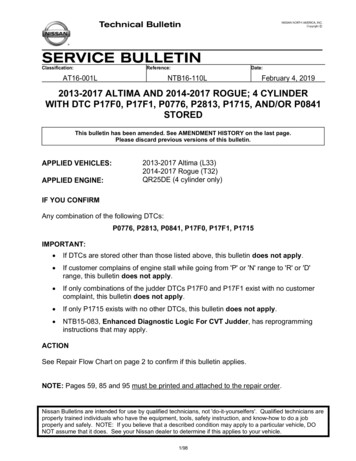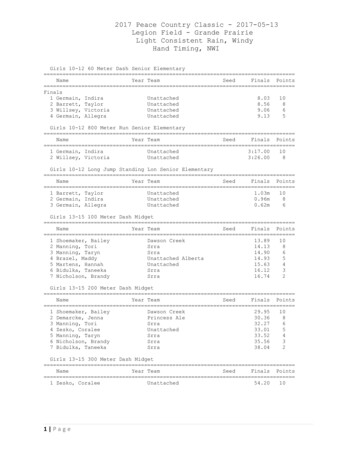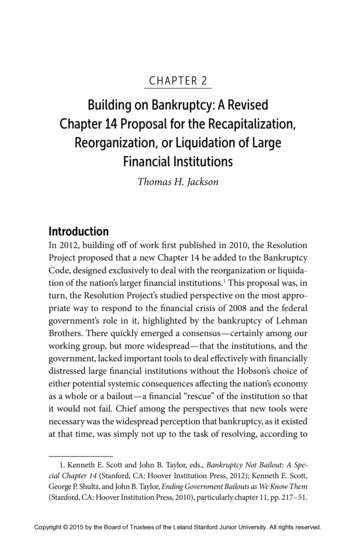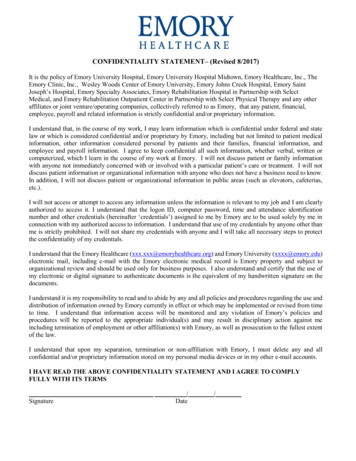
Transcription
CONFIDENTIALITY STATEMENT– (Revised 8/2017)It is the policy of Emory University Hospital, Emory University Hospital Midtown, Emory Healthcare, Inc., TheEmory Clinic, Inc., Wesley Woods Center of Emory University, Emory Johns Creek Hospital, Emory SaintJoseph’s Hospital, Emory Specialty Associates, Emory Rehabilitation Hospital in Partnership with SelectMedical, and Emory Rehabilitation Outpatient Center in Partnership with Select Physical Therapy and any otheraffiliates or joint venture/operating companies, collectively referred to as Emory, that any patient, financial,employee, payroll and related information is strictly confidential and/or proprietary information.I understand that, in the course of my work, I may learn information which is confidential under federal and statelaw or which is considered confidential and/or proprietary by Emory, including but not limited to patient medicalinformation, other information considered personal by patients and their families, financial information, andemployee and payroll information. I agree to keep confidential all such information, whether verbal, written orcomputerized, which I learn in the course of my work at Emory. I will not discuss patient or family informationwith anyone not immediately concerned with or involved with a particular patient’s care or treatment. I will notdiscuss patient information or organizational information with anyone who does not have a business need to know.In addition, I will not discuss patient or organizational information in public areas (such as elevators, cafeterias,etc.).I will not access or attempt to access any information unless the information is relevant to my job and I am clearlyauthorized to access it. I understand that the logon ID, computer password, time and attendance identificationnumber and other credentials (hereinafter ‘credentials’) assigned to me by Emory are to be used solely by me inconnection with my authorized access to information. I understand that use of my credentials by anyone other thanme is strictly prohibited. I will not share my credentials with anyone and I will take all necessary steps to protectthe confidentiality of my credentials.I understand that the Emory Healthcare (xxx.xxx@emoryhealthcare.org) and Emory University (xxxx@emory.edu)electronic mail, including e-mail with the Emory electronic medical record is Emory property and subject toorganizational review and should be used only for business purposes. I also understand and certify that the use ofmy electronic or digital signature to authenticate documents is the equivalent of my handwritten signature on thedocuments.I understand it is my responsibility to read and to abide by any and all policies and procedures regarding the use anddistribution of information owned by Emory currently in effect or which may be implemented or revised from timeto time. I understand that information access will be monitored and any violation of Emory’s policies andprocedures will be reported to the appropriate individual(s) and may result in disciplinary action against meincluding termination of employment or other affiliation(s) with Emory, as well as prosecution to the fullest extentof the law.I understand that upon my separation, termination or non-affiliation with Emory, I must delete any and allconfidential and/or proprietary information stored on my personal media devices or in my other e-mail accounts.I HAVE READ THE ABOVE CONFIDENTIALITY STATEMENT AND I AGREE TO COMPLYFULLY WITH ITS TERMS/ /SignatureDate
Acknowledgement of Privacy and Security Awareness TrainingFor Emory Healthcare Temporary Employees, Contractors,Vendors, Students, and Emory University employeesI am, or in the future may become, a user of one or more Emory Healthcare information technologydevices or systems that may include electronic Protected Health Information (ePHI) and ProtectedHealth Information (PHI) in any other medium and I hereby certify that:1. I have reviewed the Emory Healthcare “Privacy and Security Awareness Training” handout.2. I recognize the importance of maintaining the confidentiality and integrity of the ePHI and PHIthat I work with for my job duties.3. I agree to abide by the Emory Healthcare policies and procedures as explained in the EmoryHealthcare “Privacy and Security Awareness Training” handouts.4. I understand that, by not following Emory Healthcare policies and procedures, I could be subjectto disciplinary actions or civil or criminal penalties.5. I have had an opportunity to ask questions regarding the “Privacy and Security AwarenessTraining”. I can call 404-778-2757 if I have questions regarding the training.FAX this completed form along with the signed Confidentiality Statement to EHc IS AccessManagement – 404-727-0759 or email scanned forms to issecurity ehc@emoryhealthcare.org.You may contact your access coordinator with questions regarding logonID access.SIGNATURE and AFFILIATIONDATEPRINT NAMEDEPARTMENT/SECTION2
Privacy and Security Awareness Training – (Revised 05/2017)For all Emory Healthcare Workforce Members, Temporary Employees, Contractors,Vendors, Students, and Emory University employeesThe Health Insurance Portability and Accountability Act (HIPAA) Privacy and Security Rules regulatethe use, disclosure, privacy, confidentiality and security of Protected Health Information (PHI) inwritten, verbal and the transmission, storage and disposal of PHI in electronic form.In this document you will learn: To identify PHI and patient information to be protected To better understand how to protect PHI and the risks when using and storing PHI & ePHI. To better understand how to reduce those risksWhat are we going to cover?o Patient Health Information (PHI) and Electronic Patient Health Information (ePHI)o Privacy & Security Reminderso Protection from Malicious Softwareo Log-In Monitoringo Password Managemento SanctionsStandards for Privacy of Individually Identifiable Health Information (IIHI) To protect and enhance the rights of consumers by providing them access to their healthinformation and controlling the inappropriate use of that information. To improve the quality of health care in the United States by restoring the trust in the health caresystems among consumers, health care professionals, and the multitude of organizations andindividuals committed to the delivery of care. To improve the efficiency and effectiveness of health care delivery by creating a nationalframework for health privacy protection that builds on efforts by states, health systems andindividual organizations and individuals.Definition of Privacy The right of an individual to be left alone, including freedom from intrusion into one’s privateaffairs and the right to maintain control over certain personal information.Definition of Confidentiality The responsibility for limiting disclosure of private matters including the responsibility to use,disclose, or release such information with the knowledge and consent of the individual.Definition of Security The means to control access and protect information from accidental or intentionaldisclosure to unauthorized personnel and from alteration, destruction or loss.3
Definition of PHI Protected Health Information (PHI) Is any health information that may identify the patient and that relates to:– Past, present or future physical or mental health condition; or– Healthcare services provided; or– Payment for healthcare– Includes all communication media – written, electronic and verbal.– Extends to all individually identifiable health information in the hands of EmoryHealthcare. Identifiers of Protected Names of relativesName of employerDOBTelephone numberFax numberE-mail addressFinger or voice printsPhotographic images–––––––SSNMedical record numberHealth plan beneficiary numberAccount numberCertificate/license numberVehicle or other device serial numberIP address any other unique identifier,character, code(Any other identifying information that could reasonably identify the patient) Examples– Financial records– Test results– Data stored on Intranet/Internet– Data used for research purposes– A patient’s identification bracelet– Medical record number and diagnosisDe-Identification of PHI and Limited Data SetsDefinition of De-Identification Health Information that does not identify an individual and that there is no reasonable basis tobelieve that the information can identify an individual is not individually identifiable healthinformation.– Health information is considered de-identified if: It has been determined by the appropriate person that the risk is very small that theinformation could be used to identify an individual. It meets the safe harbor method which is the removal of all of the individualidentifiers from the health information. EHC may de-identify information and use codes or other similar means of markingrecords so they may be later re-identified.What is Electronic Patient Health Information (ePHI)? The definition of ePHI includes any PHI created, received, stored on hard drives, networks laptops,memory sticks and PDAs; contained in e-mail; or transmitted electronically.4
Examples of ePHI include, but are not limited to:– Laboratory results that are emailed to a patient,– Demographic information about a patient contained in EHc information systemssuch as Power Chart and Millennium– A note regarding a patient stored on your Palm Pilot– Billing Information that is saved to a CD or disk, and– A digital photograph of a patient stored on your hard drive.SecurityIsn’t this just an Information Technology Problem? NO ! ! ! ! Good security Standards follow the “90/10” Rule:– 10% of security safeguards are technical– 90% of security safeguards rely on the computer user (“YOU”) to adhere to goodcomputing practices– Example: The lock on the door is the 10%. You remembering to lock thedoor, check to see if it is closed, ensuring others do not prop the door open,and keeping control of your keys is the 90%.Risks What do I need to do to protect ePHI, PHI or other confidential information? at my EHc workstation on a mobile device First: Understand the Risks: Identify the risks at your workstation or in your area of work, for example– Shared passwords– Failure to log off after each use– Use of unlicensed software– Viruses– Unlocked offices and file cabinets– Medical Records laying on a nursing station– WOW Carts not disconnected Reduce risks at your workstations and in your work area Get help with Questions or Concerns Report suspected Security and Privacy incidents/breachesSecurity Reminders** Be ALERT to Reminders and follow directions accordingly ** What are Security Reminders?– Ensure that periodic security updates are issued to the workforce concerning EHCpolicies and procedures– Warnings are issued to the workforce of potential, discovered or reported threats,breaches, vulnerabilities or other HIPAA security incidents– EHc Information Services Security Policies– Security Messages on Logon banners– Security Best Practices (i.e., how to choose a good password, how to report asecurity incident)– They can be sent via email “IS Announcements”5
Protection from Malicious Software: Emory Healthcare has developed and implemented procedures for guarding against, detectingand reporting new and potential threats from malicious code such as viruses, worms, denial ofservice attacks, or any other computer program or code designed to interfere with the normaloperation of a system or its contents and procedures. NEVER open an email attachment, unless you know who sent it and why.– If in doubt, call the sender of the email to confirm that the attachment is safe andvalid ALWAYS run an updated Antivirus tool, Do NOT cancel the scheduled scan NEVER load software that you or your Department is not licensed to use on an EHcworkstation. ALWAYS close “pop-ups” when they solicit a response to advertisements or othermessages– Click the “x” box to close the pop-up ads– Clicking “No” is the same as clicking “Yes” and allows the virus or hacker accessto your workstationEmail* Be AWARE Email is Never 100% secure. ** Do NOT forward humor stories, chain letters, political or religious views, e-cards, etc. NEVER send, reply or forward Emory ePHI to a non-Emory mail account (IE; Yahoo,Hotmail, AOL, or gmail etc.) Be vigilant when e-mailing patients. Don’t forget an e-mail address is a patient identifier.** When using the Emory/Emory Healthcare MS Exchange email system, please ensure you are sendingemails securely to an approved user, by following these steps:1. All emails sent to an Emory healthcare (@emoryhealthcare.org) email address are SECURE!2. For an Emory University (@emory.edu) email address, you must do the following to ensure it isSecured:a. Locate user in Global Address list (GAL) or address book6
b. Verify the icon to the left of the user:1. If it is a little red person:Then the email is secured and it is OK to email this person.2. If it is little red person with a globe in front:containing ePHI or sensitive emails.DO NOT send the user any emailsLogon and Access Monitoring Emory Healthcare monitors your logon attempts to the EHc electronic Information Systems You must ONLY access EHc Information Systems through YOUR userid and password. If you do NOT share a computer, and you notice another user signed onto your workstation whileyou were away; either confirm the user had their own logon id or report it to the Call Centerimmediately.Incident Handling Report erratic workstation behavior or unusual Email messages to your department Manager, Dept.IS resource or EHc Call Center. Report any suspected issues or incidents to a manager or the EHc Call Center Report lost or stolen devices to EHC IS department and the Emory Police Department and whenappropriate to the Local Police.Passwords Protect your userid and password. YOU are responsible for actions taken with you userid andpassword Do NOT post, write or share passwords with anyone. The HIPAA Security Rule requires EHc to be able to audit an individuals actions usingePHI. Protect you userid and password from fraudulent use or unethical behavior. Use STRONG passwords that are hard to guess, easy to remember and change them often. Do NOT use a word from a dictionary - English or otherwise. Create a password between 9-30 characters (letters, numbers, and special characters) Or use a pass phrase and add 2 numbers or a symbol to help you remember your password:– EGbDF42dY (every good boy does fine for today) or– ILV2GLF4fn (I Love to Golf for fun) Use password protected Screen savers on EHC workstations, laptops, and PDAs Always Logoff/Disconnect from shared workstations. If you do not logoff, someone else could use your userid to illegally access ePHI.Patients Rights Right to receive a notice describing the covered entity’s privacy practices.7
Inform patients how to file complaints, either with the covered entity or DHHS. Identify a contact person who can provide additional information. Right to access, inspect, and copy protected health information that is used, in whole or in part, tomake decisions about them. Right to request amendment of protected health information. Right to receive an accounting of disclosures made by a covered entity for purposes other thantreatment, payment, and health care operations made within six years prior to the request. The accounting must be provided within 60 days after receipt of the request. Right to request restrictions on the use and disclosure of their protected health information. Patients may ask health care providers and plans to communicate health information to them by“alternative means” or at “alternative locations”.Sanctions A violation of the Security Rule could also be a violation of the Privacy Rule and State Laws Civil Monetary Penalties range from:– Where the person did not know, and by exercising reasonable diligence would not haveknown:o 100 for each violationo Not to exceed 25,000 in a calendar year– Where the violation was due to reasonable cause and not to willful neglect:o 1,000 for each violationo Not to exceed 100,000 in a calendar year– Where the violation was due to willful neglect and was corrected:o 10,000 for each violationo Not to exceed 250,000 in a calendar year– Where the violation was due to willful neglect and was not corrected:o 50,000 for each violationo Not to exceed 1,500,000 in a calendar year Criminal Penalties– Range from 50,000 - 250,000 and imprisonment for a term of 1 – 10 years EHc corrective and disciplinary actions, up to and including terminationRevised 5/20178
– E -mail address – Finger or voice prints Photographic images – SSN – Medical record number . – WOW Carts not disconnected . Don’t forget an
